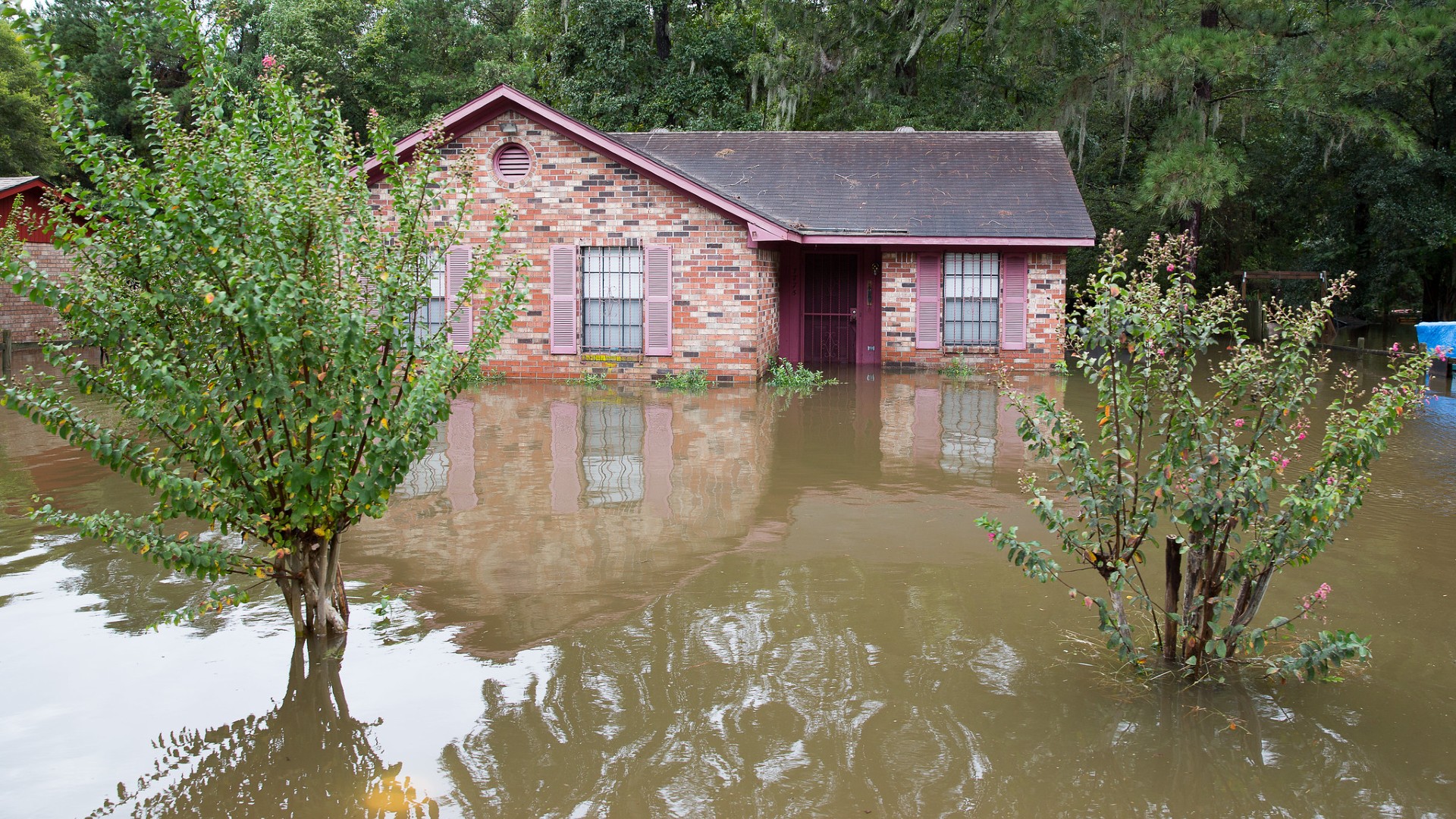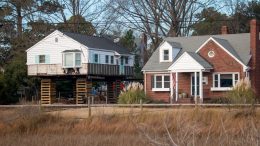Sea levels are rising around the world — but not evenly.
One area already getting swamped is the Southeast United States, where sinking land, rising seas, and a slowing Gulf Stream are causing waves to lap at city streets even on sunny days.
Climate change is also bringing another wet threat: supercharged storms carrying more moisture, leaving low-lying coastal areas awash.
As city leaders figure out how to meet these challenges, they have to weigh decisions about whether to build sea walls or improve wetland habitat. Or a combination of so-called “gray” and “green” infrastructure.
“I think that for a lot of the country, sea-level rise can sort of seem like an abstract concept,” says Claudine Ebeid McElwain, host of the “Broken Ground” podcast, which covers environmental stories in the South. “But for the people that we’ve met, it’s affecting their everyday lives.”
Lately she’s been talking to residents, city officials and others working on coastal resilience solutions in frontline communities like Norfolk, Virginia and Charleston, South Carolina.
“Broken Ground” is produced by the Southern Environmental Law Center, which also works to address these issues through legal action.
“Sea-level rise is really causing an existential crisis for these cities,” says Chris DeScherer, Southern Environmental Law Center’s Charleston director. “It’s really going to be a monumental challenge for communities all up and down the Southeast coast.”
We spoke with McElwain and DeScherer about how Charleston and other cities are navigating these issues and how they can make sure solutions don’t leave out vulnerable communities and coastal ecosystems.
Sea-level rise often seems like a distant problem. What have you learned from talking to people who are already affected?
Claudine Ebeid McElwain: When you start talking to people in these communities, this abstract issue really becomes very concrete.

We have a recent episode about Norfolk featuring one woman who is dealing with rising waters repeatedly coming into her home. We met another homeowner who’s already had four neighbors on his street bought out by the city with FEMA money [so their houses could be torn down and returned to wetland]. In that episode we talk about this idea of “managed retreat” and what that means in the context of rising seas.
We’re taking a hard look at how people are going to practically address this issue and what it means for their lives. When you’re talking about folks, especially when you’re talking about people in low income and vulnerable situations, it begs the question of how we can do right by the decisions we make.
Charleston faces a big decision right now about to address these problems. What’s happening there?
Chris DeScherer: The Army Corps of Engineers is proposing to build a seawall around Charleston to address storm surge.
It’s a nearly $2 billion proposal and we have some significant concerns about it. For starters, they’re not planning an environmental impact statement to study the proposal, which I think is a mistake because it’s one of the most significant and expensive construction projects perhaps in the history of Charleston. It deserves the most rigorous form of review to make sure that it’s a wise investment. (Editor’s note: The Corps completed a draft Environmental Assessment, a less comprehensive review, and claims the full Environmental Impact Statement is not needed because the project “would not cause significant adverse effects on the quality of the human environment.”)
Another problem, as engineers around town have already pointed out, is that there’s a greater than 40% chance the wall would be overtopped by a storm surge in the next 50 years.
Once that happens, you’re exacerbating the whole problem because you’re basically trapping all that water inside the peninsula.
Another issue is that the Corps is single-mindedly focused on storm surge when there are multiple sources of flooding that threaten cities like Charleston. Storms are already more powerful due to climate change and are dumping more water. And [a wall] obviously does nothing about that. It’s also not meant to address tidal flooding, which is an increasing problem, too.
Are you concerned about harm to the coastal ecosystem from a seawall as well?
DeScherer: Yes. There’ll be a lot of impacts to the fringe of wetlands around the city. Our coastal marshlands are among the most productive ecosystems we have. So losing wetlands is obviously a problem.

There are also environmental concerns associated with what happens when you build a structure like this. Could the wall, by changing water patterns and circulation patterns in the harbor, actually increase erosion and harm in places adjacent to the city? That’s something that the Corps acknowledged that it really hasn’t studied yet.
There are also two historically African American communities — Rosemont and Bridgeview Village— [that] the wall stops short of protecting.
I think there are some significant questions of equity here, too. Is it fair to spend $2 billion trying to protect peninsula Charleston? What about the other parts of Charleston that are struggling with erosion, sea-level rise and flooding?
Are there alternatives to this type of infrastructure?
McElwain: Some of the most innovative stuff I think is going to be how cities think about restoring wetlands and using the wetlands to their advantage.
Norfolk and Charleston are actively working to find places that they can return to a green space. In both places, areas that are currently and constantly getting flooded were formerly creeks and wetlands that we chose to fill. So we’re looking at having to readjust to the land.
DeScherer: In its study, the Corps purports to consider a wider range of alternatives than just a wall, but very early on in its process it rejected those greener solutions. It didn’t carry them forward for a rigorous enough review.
What we want to do now is take those types of solutions that the Corps rejected and really develop them and show why they are a better way forward to the city. We’re hiring, along with the Coastal Conservation League and our other partners in town, experts who have worked around the country to design greener forms of protection for communities. These might have multiple benefits — including being cheaper and more effective at addressing the broader range of flooding threats.
Are you seeing that cities are beginning to say no to development in vulnerable areas?
DeScherer: Here in the Lowcountry we can’t afford to make this already huge problem worse by putting new development into vulnerable areas, such as wetlands and floodplains.

Wetlands are those places on our landscape that are natural reservoirs for storing floodwaters. The last place that we should be putting new development these days is into the places on our landscape that actually protect communities from flooding. Unfortunately, though, we continue to see that here in coastal South Carolina.
For example, there’s a proposal in an area of the city of Charleston called West Ashley, where a development would fill more than 200 acres of wetlands in a watershed that’s a poster child for flooding problems. In fact, the city has worked for years to voluntarily buy out repetitive flood properties in this area.
There’s also a proposal in an area of town called the Cainhoy peninsula that’s adjacent to the Francis Marion National Forest. It’s surrounded by marshlands. It’s very low lying with extensive floodplains. And there’s a massive proposal to construct 9,000 new residential housing units and commercial development on 9,000 acres. It’s very vulnerable to storms, storm surge and flooding. This isn’t the kind of development that’s going to make us more resilient.
I think it’s built into our mentality that more growth, more development is better for the economy. The reality, I think, is that we can still grow. We just have to be smarter about it. We have to avoid wetlands, we have to avoid floodplains. And we have to develop in denser ways.
Are there changes that industry needs to make as well?
DeScherer: There’s a lot of attention on flooding, but way less about what is in the flood water. In the southern states that we work in along the Atlantic and in Alabama on the Gulf Coast, there’s a lot of industry that’s grown up alongside ports.
These industrial sites handle toxic pollutants, but many of their stormwater plans were developed years ago. And the nature of storms is changing and has already changed. A normal storm now can bring more rain.
So we’re working to help ensure that these industrial sites are appropriately upgrading their best management practices and stormwater plans in order to control the discharge of toxic pollutants into our waterways and communities.
And septic systems and municipal-wastewater treatment systems in increasingly flooded areas also will not work as well. For example, in Charleston a couple of years ago, the Post and Courier went around the city after rain events and sampled the waters for bacteria pollution. It was pretty eye-popping for a lot of people to see the bacteria numbers that are actually in the floodwater.
Climate change is just going to present all sorts of challenges for our communities on the coast.
We’ve focused a lot on cities, but this problem is far-reaching. What more do we need?
DeScherer: We need a federal government that is not undermining our critical environmental statutes, like the National Environmental Policy Act, like the Clean Water Act, like the Endangered Species Act.
It’s critical that we defend our federal environmental statutes, but it’s also important on a local level and on a state level. We really need all three levels of government implementing law in a fair and evenhanded way in order to ensure that decisions are made that are protective of communities and the environment.
![]()


